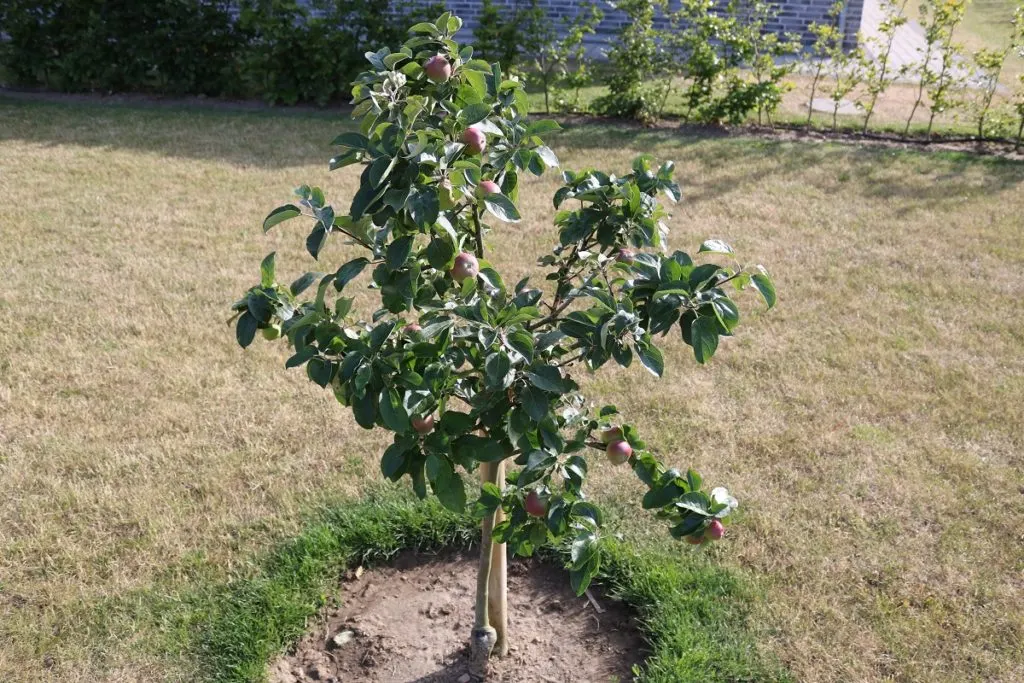
Apple, cherry, plum, and other fruit trees are always a splendid addition to the edible landscape.
Gorgeous in every season, fruit trees put out a mesmerizing display of fragrant blooms in spring and dramatic, fiery foliage colors in fall. And during the dog days of summer, they bear bushels and bushels of fruit, sweeter and juicer than anything you could buy at the store.
Standard-sized fruit trees are long-lived specimens that can become quite massive in time. Mature apple trees have a height and spread of around 30 feet. Naturally smaller trees, such as peach and nectarine, can reach up to 15 feet tall and wide.
Dwarf fruit trees, by contrast, are much smaller in stature. Typically reaching around 8 to 10 feet tall and wide, these miniature beauties will provide an abundance of full-sized fruit each season but are much easier to manage and care for than their towering counterparts.
Whether you wish to grow a tiny orchard or a single fruit tree, dwarfing varieties are a clever solution for growing fresh fruit in small spaces.
What is a Dwarf Tree?
Dwarf trees are able to maintain their petite and compact proportions thanks to the horticultural technique known as grafting.
Grafting is a form of asexual reproduction that involves joining the parts of two or more living trees together.
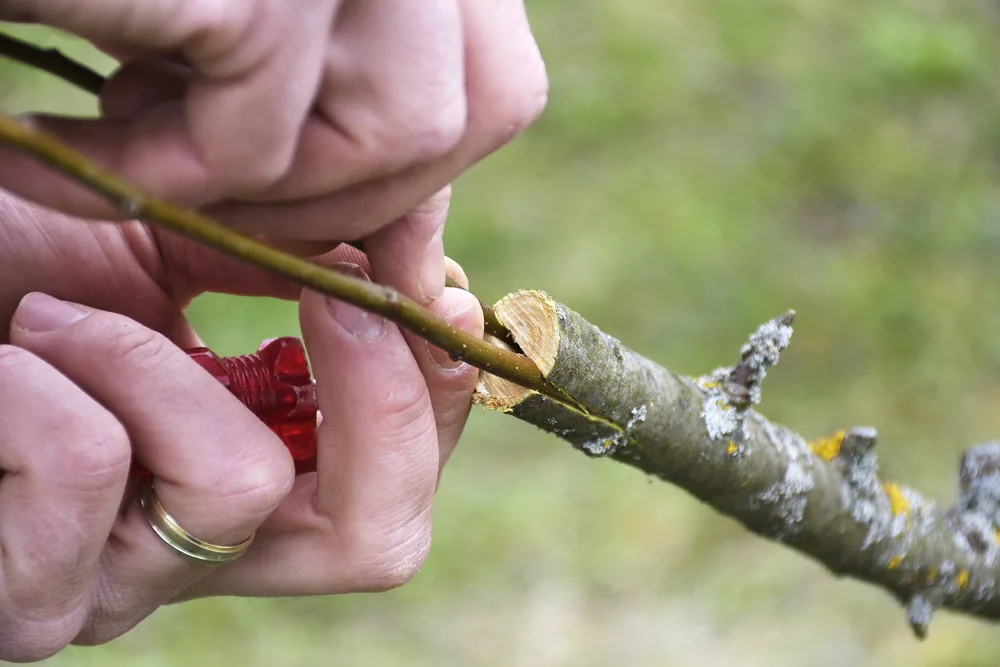
It involves taking a cutting from the upper portion of the parent fruit tree. This is called the scion, a selection of branches with budding tips.
The scion is carefully joined to the rootstock of another compatible tree. Much of this rootstock is underground and includes the tree’s root system with a short trunk.
The upper and lower portions of these two trees are conjoined where each were cut, callousing together as they heal.
While the scion is chosen for its good fruit-bearing characteristics, the rootstock will determine the tree’s size at maturity, its pest and disease resistance, its hardiness, and the soil type it grows best in.
Most fruit trees are propagated by grafting scion to rootstock to ensure consistency, and there are many different kinds of rootstocks to choose from.
For example, an apple tree with an M25 rootstock will grow to be a standard 30 feet in size. The same variety of apple grafted to an M9 rootstock will be dwarfed to only 8 feet. The semi-dwarf rootstock MM106 will keep the tree’s final size to around 16 feet.
Then there are multi-grafted fruit trees. When more than one scion is joined to the rootstock, a single apple tree, for instance, could yield several kinds of apples, like Fuji, Gala, Red Delicious, and Golden Delicious varieties.
7 Benefits of Dwarf Fruit Trees
The more diminutive size of dwarf fruit trees brings with it lots of fringe benefits:
1. Good for small spaces
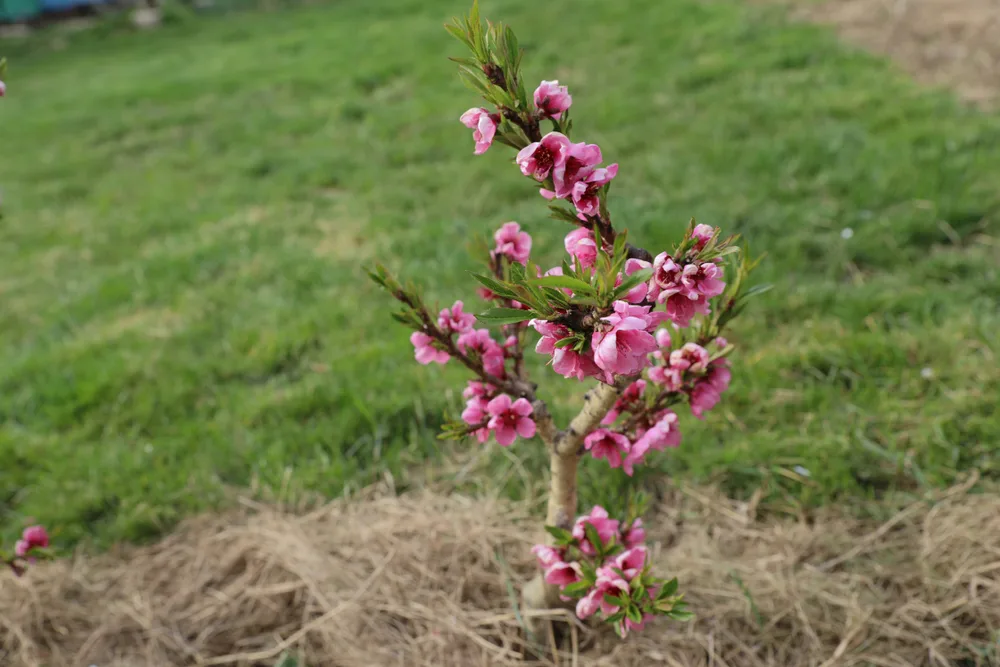
Clearly, dwarf fruit trees are the ideal for smaller outdoor spaces. Some dwarfing rootstocks can limit tree size to just three feet tall and wide, making it possible to plant fruit-bearing trees in tiny yards and gardens.
Many kinds of dwarf fruit trees are good candidates for container gardening and can be set out on a balcony or patio.
2. Easier care
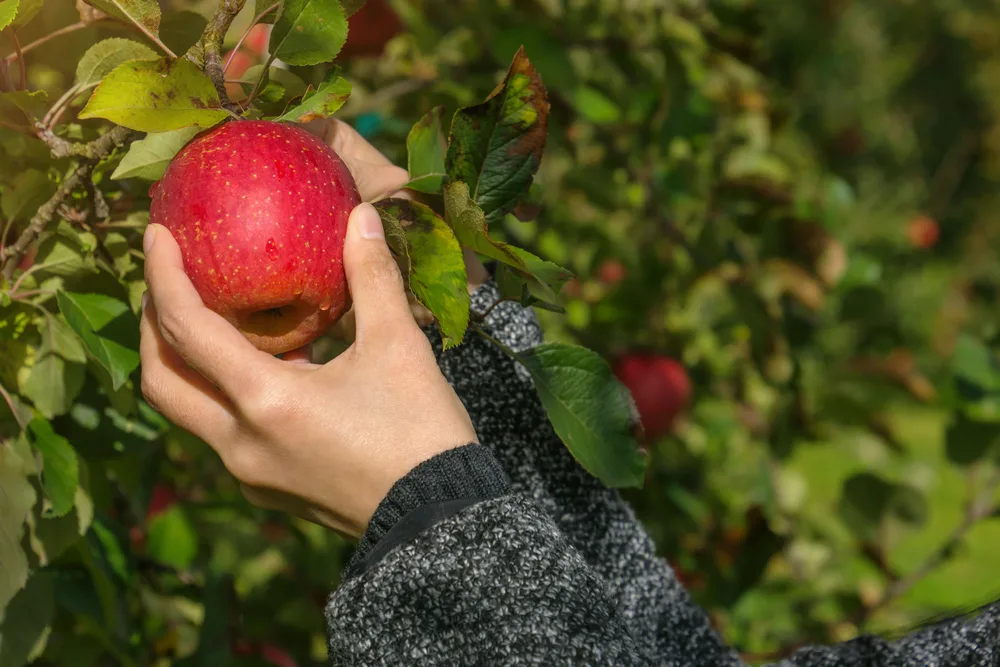
Because dwarfed trees grow no larger than 10 feet, maintaining the tree over the course of its lifespan is so, so much easier.
Tree pruning and fruit harvesting can be accomplished from the relative safety of the ground – no need to clamber over a ladder to reach the top of the tree’s canopy.
3. Faster fruit
Smaller trees also reach fruit-bearing age sooner than standard size fruit trees.
Once transplanted in the ground or in a pot, dwarfing varieties will produce fruit in only a year or two. Standard-size fruit trees can take around 5 years before they start setting fruit.
4. Denser plantings
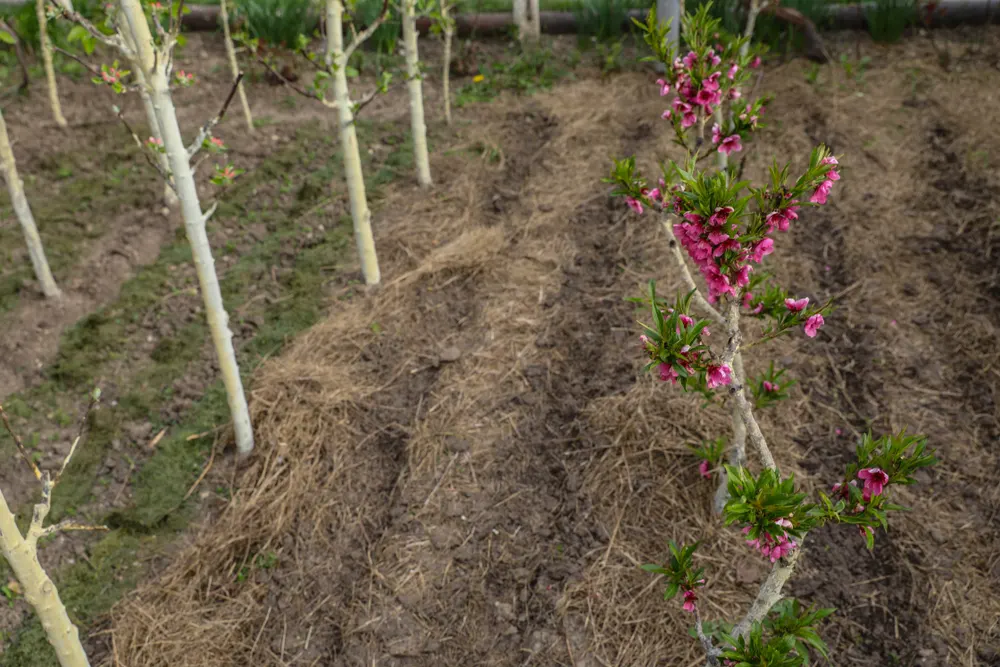
The compactness of dwarf fruit trees also means they don’t need much space to grow and can be planted more closely together compared to their full-fledged relatives.
Dwarf trees can help maximize the use of garden space by allowing for multiple plantings. The smallest types can be planted densely to create a flowering and fruiting privacy hedge.
5. Trainable
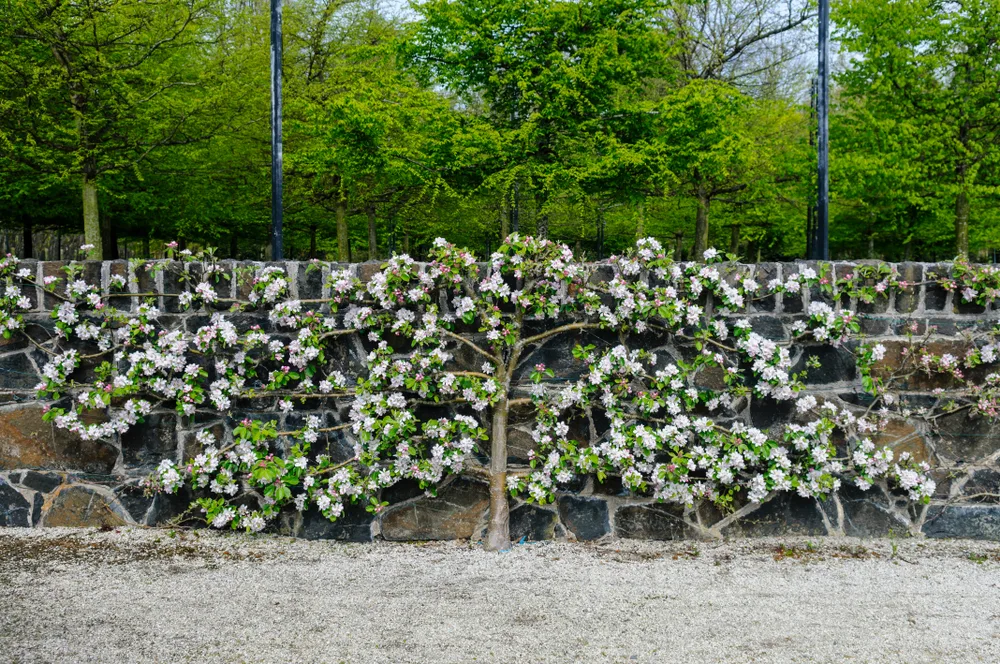
Espalier is the ancient technique of pruning and tying growing tree branches against a wall, fence, or trellis. Trees grown along a flat, two dimensional surface can be trained into creative shapes and patterns to save on space and make a living work of art.
Due to their limited growth potential, dwarf fruit trees are great choice for espalier training. And while any woody plant can be trained in this manner, some of the most tried-and-true fruit trees for espalier include apple, fig, stone fruits, and citrus.
6. Customizable
Thanks to grafting, fruit trees can be entirely customized.
There’s a great diversity in grafting rootstocks and their characteristics. Drought tolerance, disease resistance, cold hardiness, early fruiting, ability to grow in poor soils, and of course, size, are some of the optional traits.
Some tree nurseries will throw together a special Frankentree just for you.
7. Transportable

When grown in containers, dwarf fruit trees can travel with you wherever you go – no need to leave behind a mature tree when you move.
Another advantage of a portable orchard is that container-grown dwarf trees can also be moved indoors during winter. This opens up a world of possibilities for growing tropical trees in cold climates.
And a Few Drawbacks…
Shorter lifespan
Dwarf fruit trees will generally live for quite a long time, around 15 to 20 years. However, that’s less than full-sized trees that tend to live for 35 to 45 years.
No shade
Dwarf trees are too short and narrow to provide much by way of shade. If you fantasize about lounging beneath your fruit tree over the summer, you’re better off with a semi-dwarf or standard size fruit tree.
Lower yields
While it’s true that dwarf fruit trees will provide comparatively less fruit than their full-sized kin, these little trees will still give loads of fruit come harvest time.
A dwarf apple tree, for instance, will on average produce 48 to 192 pounds of fresh fruit each season. Though less than a semi dwarf (240 to 480 pounds) and a standard size (480 to 960 pounds) apple tree, dwarfed varieties often provide more than enough to feed a small family.
If you want greater yields, simply plant more dwarf fruit trees.
8 Dwarf Fruit Trees to Grow
When shopping around for dwarf fruit trees, pay special attention to traits like disease resistance, chilling hours, pruning requirements, and whether the tree is self-fertile or needs another tree to bear fruit.
1. Red Delicious Apple (Malus domestica ‘Red Delicious’)
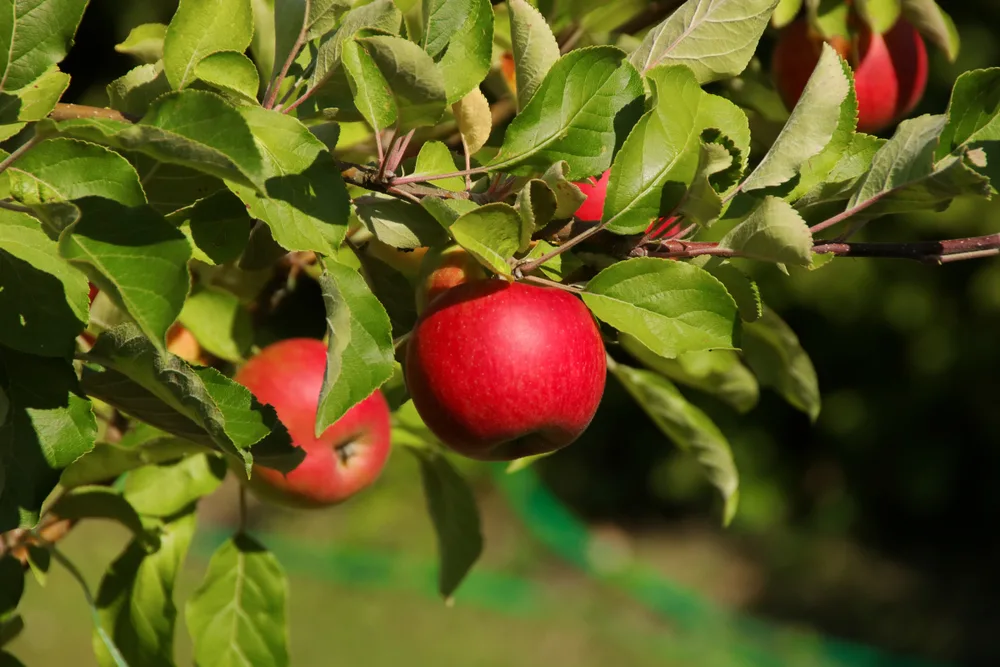
There’s a staggering amount of choice in apple trees, with more than 2,500 different varieties cultivated in North America alone.
Red Delicious is a popular pick that blooms with pinkish-white flowers in mid-spring. In autumn, it bears sweet and juicy apples that are excellent for fresh eating and cooking. The fruit has a good storage life and will keep up to six months in the fridge.
It’s important to note that apple trees are not self-pollinating. You will need a second dwarf apple tree of a different variety to produce fruit on either tree. To ensure successful cross-pollination, both dwarf apple trees should be in bloom at the same time and planted within 20 feet of each other.
Compatible pollinators for Red Delicious include other mid-season bloomers such as Golden Delicious, Gala, and Honeycrisp.
Alternatively, you can save on yard space by choosing a multi-grafted apple tree with two (or more) compatible scions.
Hardiness zone: 5 to 8
Dwarf size: 10 feet tall and wide
Chill hours: 700 to 800
Self-fertile? No
2. Elberta Peach (Prunus persica ‘Elberta’)
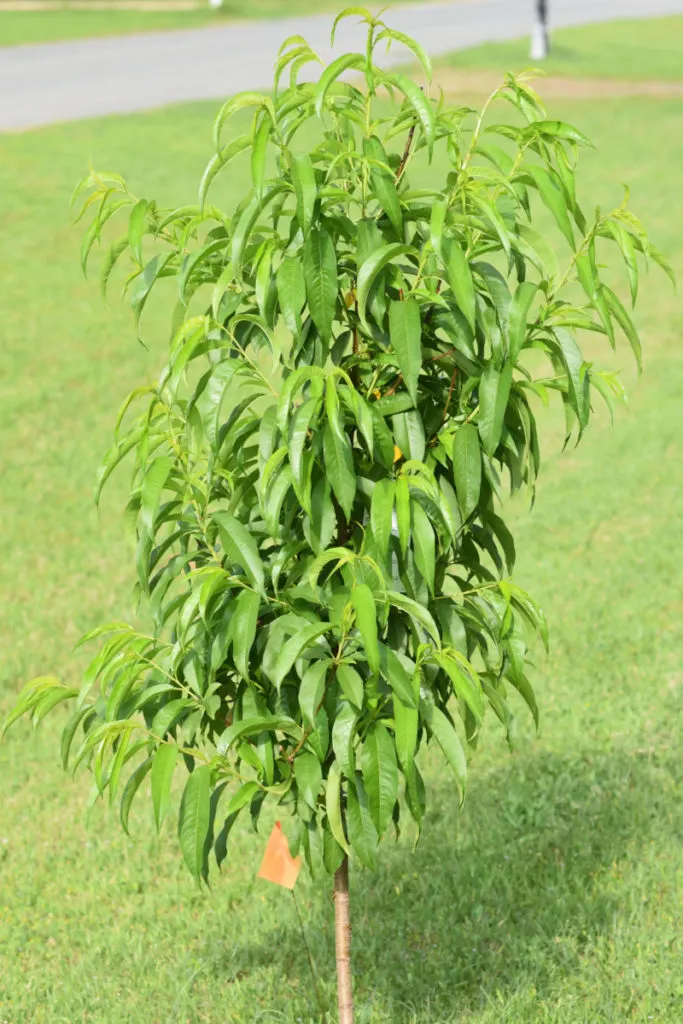
An heirloom variety that originated in Georgia, Elberta peaches are yellow freestone fruits that finish with a blush of reddish pink. These fuzzy peaches are large, juicy, and sweet – ideal for eating, freezing, canning, and jam-making.
The tree is a show stopper in early to mid-spring when masses of fragrant pink blossoms adorn its leafless branches.
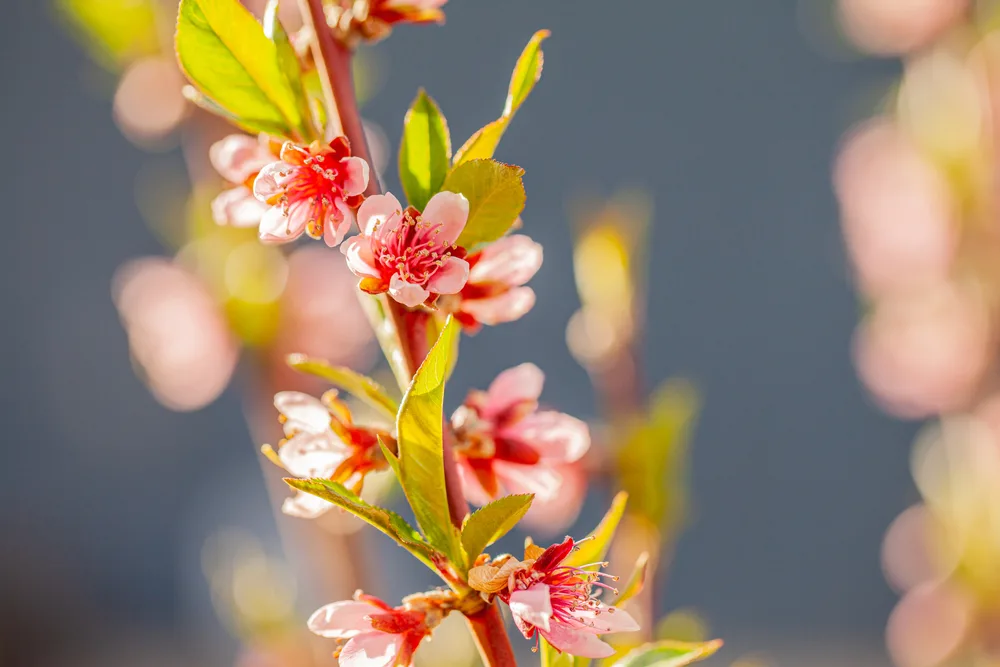
As the season wears on, fruits are ripe and ready for picking from late July to early August.
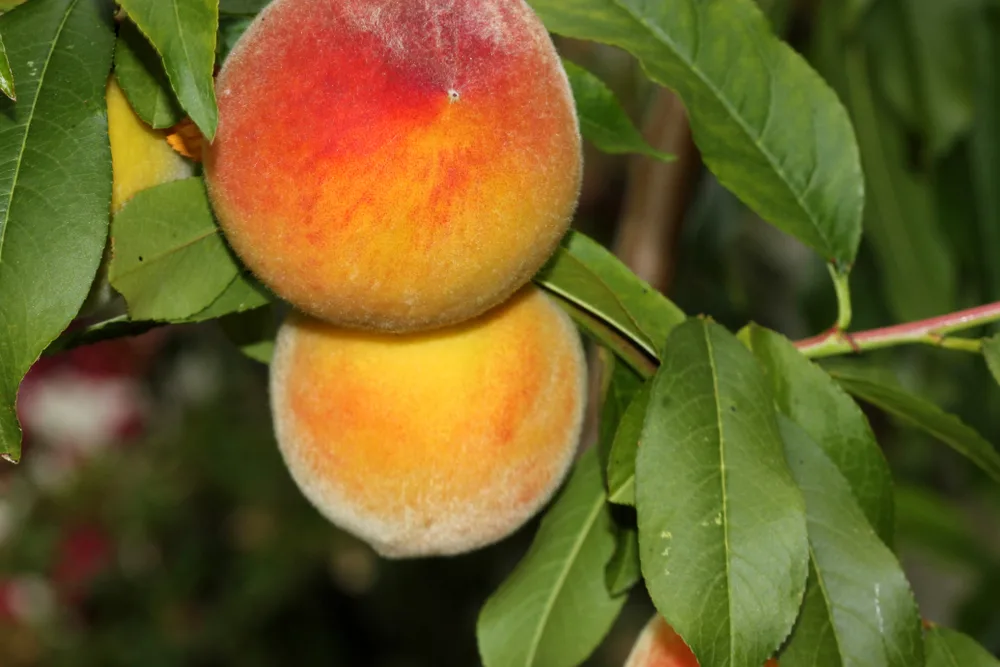
Elberta peach trees are self-fertile but will benefit from a second peach tree nearby to cross-pollinate with. Keeping at least two peach trees will vastly improve the production of fruit.
To keep your peach tree healthy and productive, annual pruning is an absolute must. This is because peach trees will only bloom and bear fruit on branches that are at least one year old.
Pruning the tree back by as much as 40% each year is necessary to simulate new growth for the following season. Older wood will eventually stop producing flower buds (and thus, fruit) and needs to be cut back to make way for new fruiting branches.
Hardiness zone: 5 to 9
Dwarf size: 8 to 10 feet tall and wide
Chill hours: 800 to 950
Self-fertile? Yes
3. Santa Rosa Plum (Prunus salicna ‘Santa Rosa’)
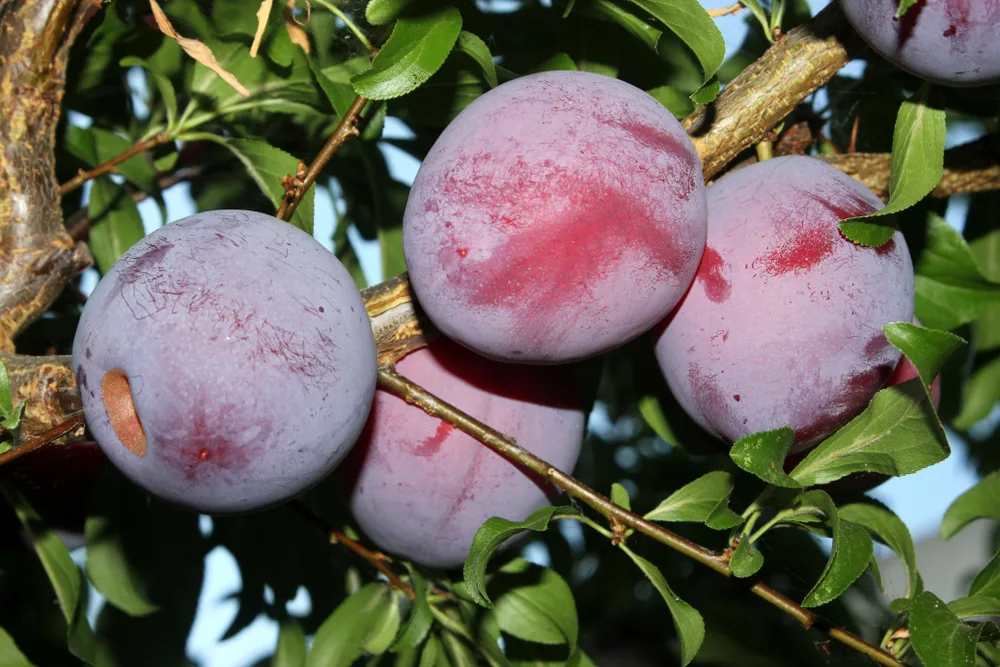
A Japanese plum, Santa Rosa is a self-pollinating plum tree that is stunning in spring and a delicious provider come July.
Santa Rosa is an early and prolific bloomer, bearing sweet and fragrant white blossoms in tight clusters along every branch and stem. The fruit is large, red to purple in color, and good for eating, canning, and cooking.
It naturally grows in a rounded canopy and requires minimal pruning to maintain its shape and allow for sunlight to reach the center of the tree.
Hardiness zone: 5 to 9
Dwarf size: 10 to 12 feet tall and wide
Chill hours: 300 to 500
Self-fertile? Yes
4. Black Tartarian Cherry (Prunus avium ‘Black Tartarian’)
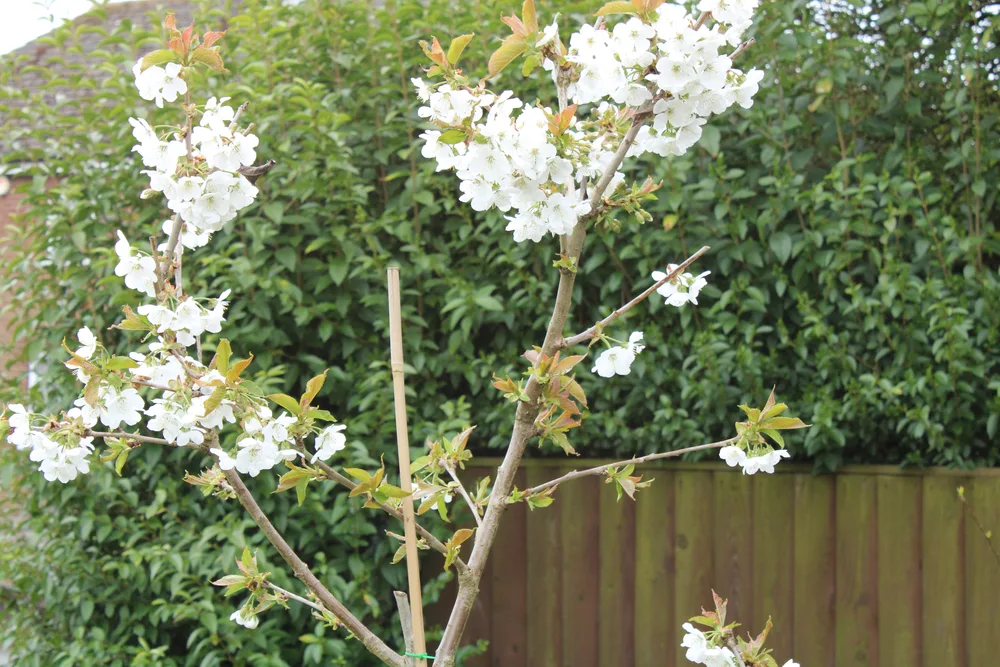
Black Tartarian cherries are tender and plump with a rich, full-bodied flavor.
The 1-inch, heart-shaped, purplish-black drupes are perfect for fresh-eating since the inner pit is smooth and separates easily from the flesh. Black Tartarian also does well in canning and preserve making.
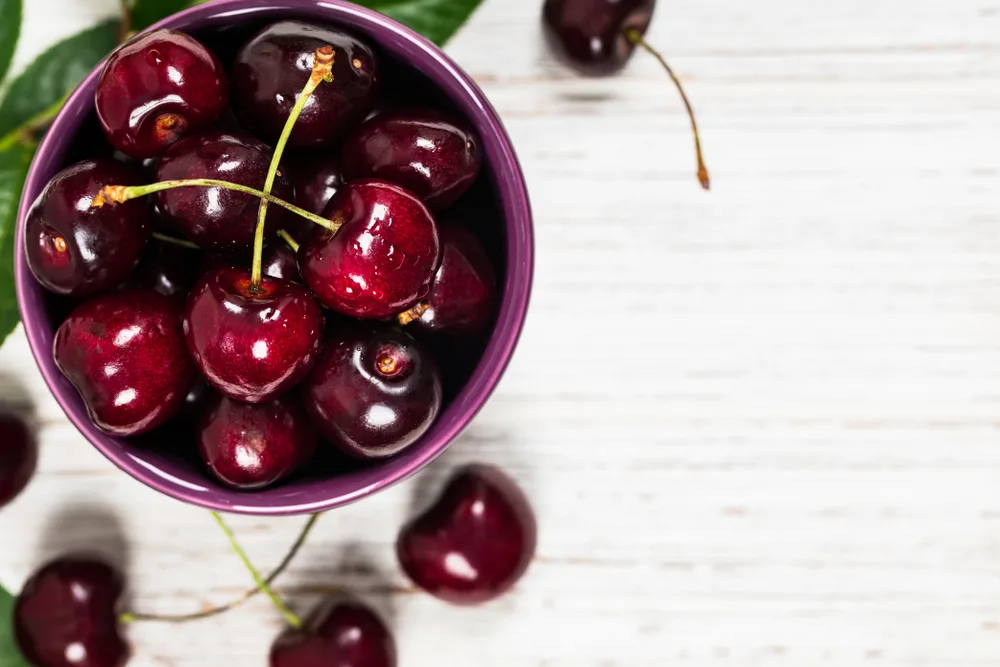
Putting out a glorious show in early to mid-spring, the white colored blossoms fill the air with a sweet scent. By mid-summer, ripe cherries arrive in clusters along the branches.
Like all sweet cherry cultivars, Black Tartarian is not self-fertile and needs a second cherry species in order to produce fruit. Plant it along with similar early blooming varieties like Bing, Stella, and Ranier.
Hardiness zone: 5 to 8
Dwarf size: 8 to 14 feet tall and wide
Chill hours: 700 to 800
Self-fertile? No
5. Washington Navel Orange (Citrus sinensis ‘Washington’)
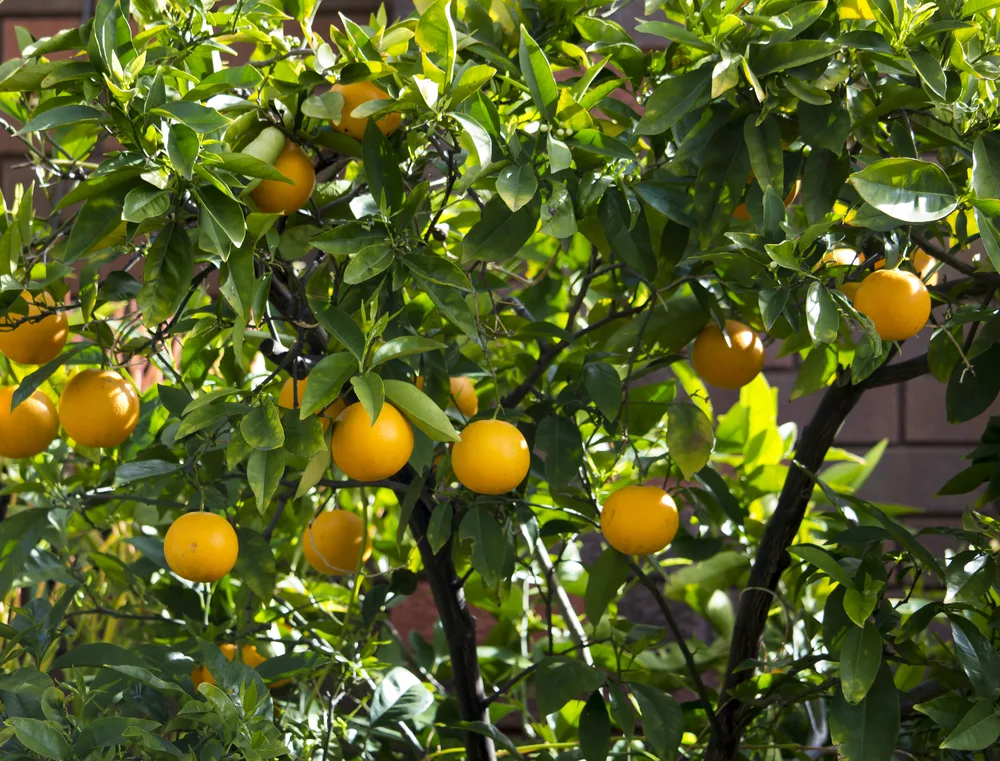
Best for fresh eating, Washington Navel oranges are seedless, easy to peel, and supremely flavorful fruits.
The dwarf version grows to be about half the standard size, but can be carefully pruned to a petite 3 feet in height.
An evergreen tree, Washington Navel orange has attractive elliptical leaves that give off a wonderful fragrance year-round. In spring, clusters of waxy, white blossoms appear along the branches.
Like all orange trees, Washington Navel loves warmth and sunlight. It grows best in temperatures between 70°F and 90°F (21°C and 32°C).
In frost-free regions, it can be planted directly in the ground. Gardeners in northern climates can grow it in containers and bring it indoors as soon as temperatures dip to 55°F (13°C) and below.
Hardiness zone: 9 to 10
Dwarf Size: 6 to 8 feet tall and wide
Self-fertile? Yes
6. Celeste Fig (Fiscus carica ‘Celeste’)
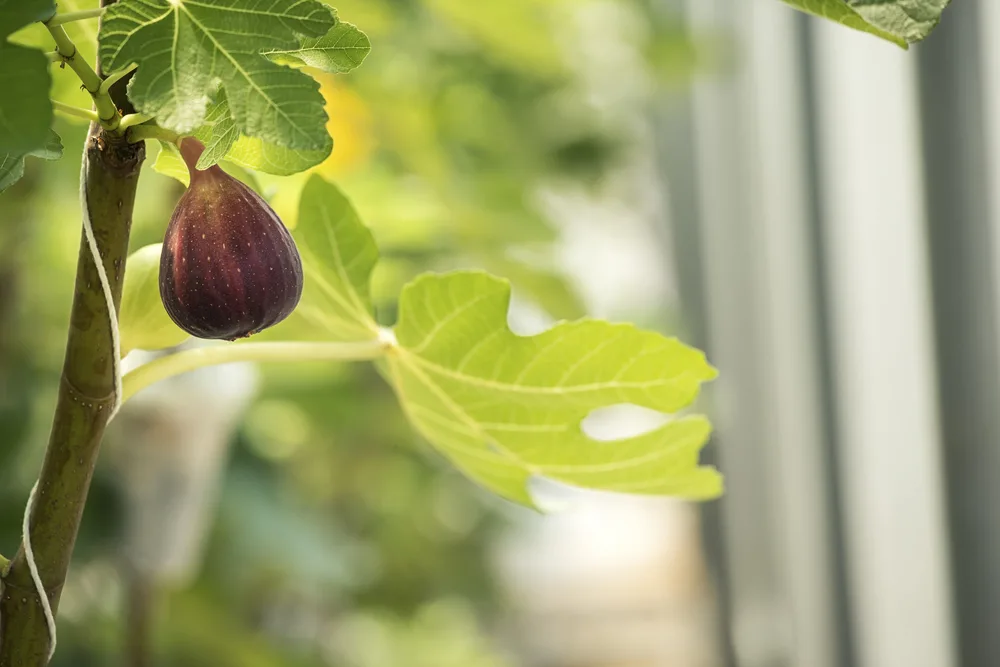
Fig trees are native to the warm and temperate regions of the Mediterranean and typically grow best in USDA zones 8 to 10.
Celeste is a much more cold hardy cultivar that can be planted outdoors to zone 6. At the cooler end of its hardiness range, it requires a sheltered location and deep mulching to survive winter temperatures of 15°F (-9°C) and lower.
Compact too, it’s a good candidate for container gardens and can be hauled indoors to overwinter in colder areas.
Maturing into a handsome multi-branched tree with silver-grey bark and deeply lobed leaves, Celeste bears small, green, and inconspicuous flowers in spring. Although it’s less showy than other fruit trees when in bloom, this little tree will provide loads of figs in late summer.
Celeste figs are small to medium in size, are bronzy-purplish in color, and have a very rich and sweet flavor. These are delectable eaten fresh off the tree or prepped in jams, preserves, and pastries.
Hardiness zone: 6 to 10
Dwarf size: 7 to 10 feet tall and wide
Chilling hours: 100
Self-fertile? Yes
7. Ice Cream Mango (Mangifera indica ‘Ice Cream’)
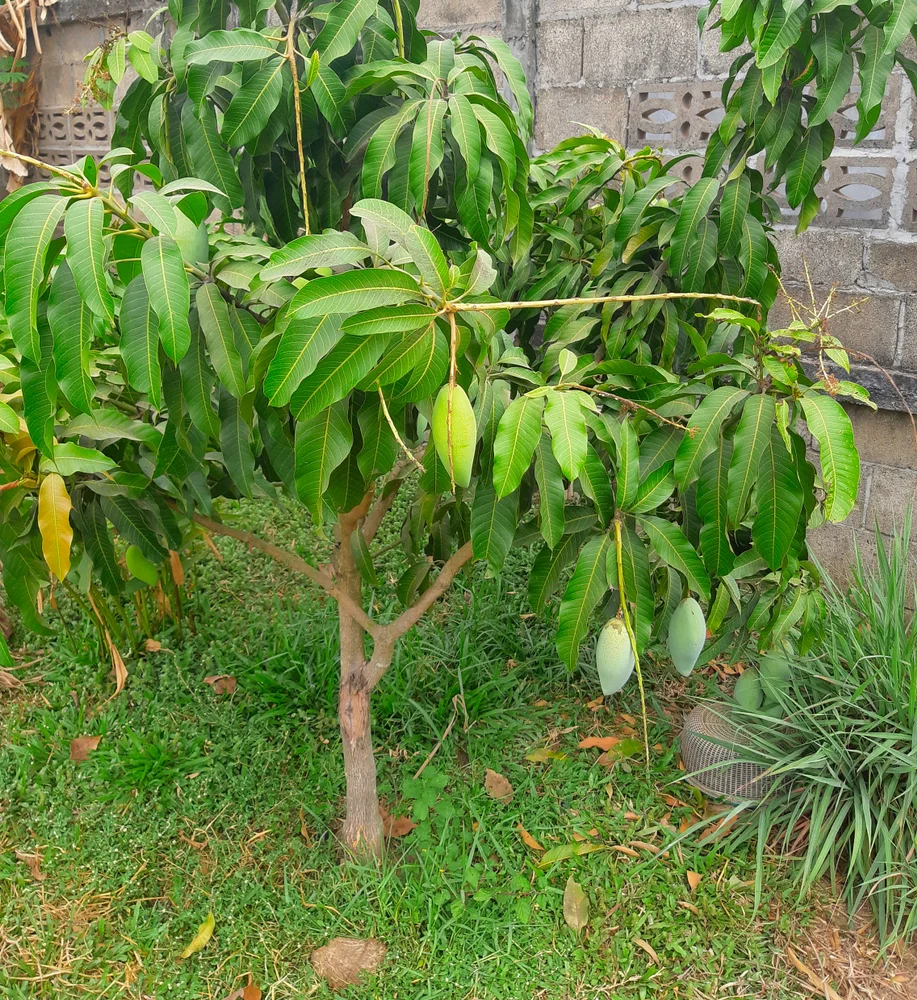
Normally, mango trees take up a ton of space and can grow to more than 100 feet in height. But dwarfed varieties, like Ice Cream, will keep your mango tree to a much more manageable size.
Ice Cream mango can be trained and pruned to only six feet tall. Known as a “condo mango” it is easily grown in containers and set out on a balcony or patio.
Although mango trees are better suited to warm, tropical climates, container-grown mangos can be placed outside in spring and summer and brought back inside before temperatures reach 40°F (4°C).
Ice Cream mangos are sweet, rich, and creamy. The fiberless fruit starts out green and will ripen to yellow as the weather heats up in June and July.
Hardiness zone: 9 to 11
Dwarf size: 6 to 8 feet tall and 4 feet wide
Self-fertile? Yes
8. Black Mulberry (Morus nigra)
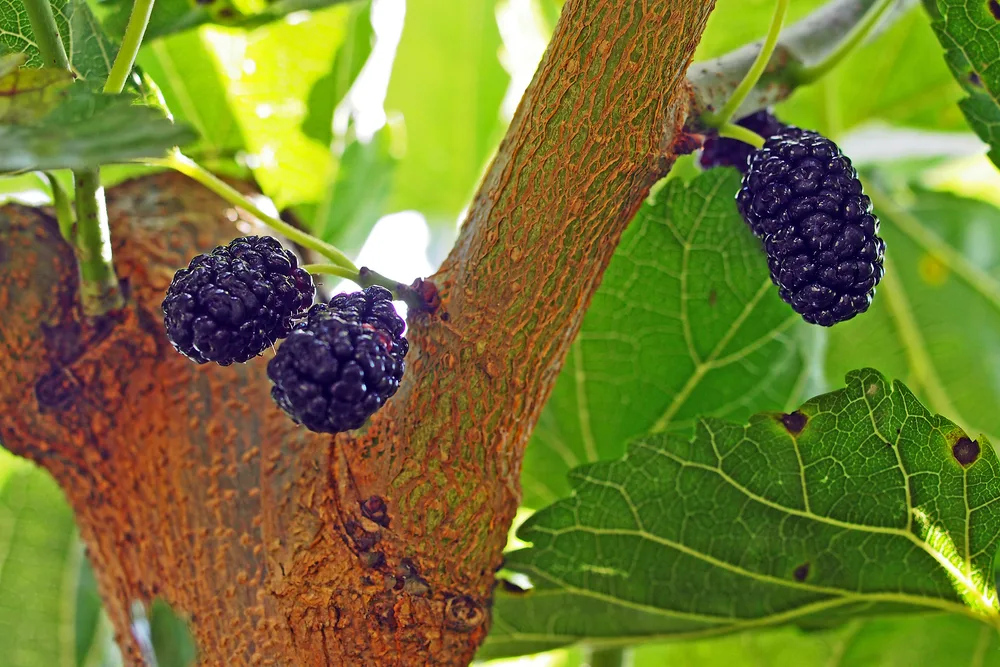
Although it’s often referred to as a bush thanks to its naturally shrubby habit, mulberry can be trained to grow into classic single trunk trees with a dense canopy.
The standard size matures to around 40 feet tall and wide but the dwarfed version can be kept under 10 feet.
Because Black Mulberry produces its delicious fruit on both old and new wood, it can be pruned back each season after fruiting has finished in autumn. This is how you can keep it to a tiny 2-feet.
Whether grown as a tree or shrub, Black Mulberry is a lovely specimen with serrate and leathery green leaves. Inconspicuous green catkins in spring turn to masses to purplish-black berries in summer.
Black mulberry fruit is considered to be the tastiest of all the mulberry species. The fruits look like oblong blackberries, each about one inch long. Juicy and sweet, these are delightful eaten fresh but are equally wonderful as jam, syrup, and wine.
Hardiness zone: 5 to 9
Dwarf size: 2 to 10 feet tall and wide
Chilling hours: 200 to 400
Self-fertile? Yes

Get the famous Rural Sprout newsletter delivered to your inbox.
Including Sunday musings from our editor, Tracey, as well as “What’s Up Wednesday” our roundup of what’s in season and new article updates and alerts.

